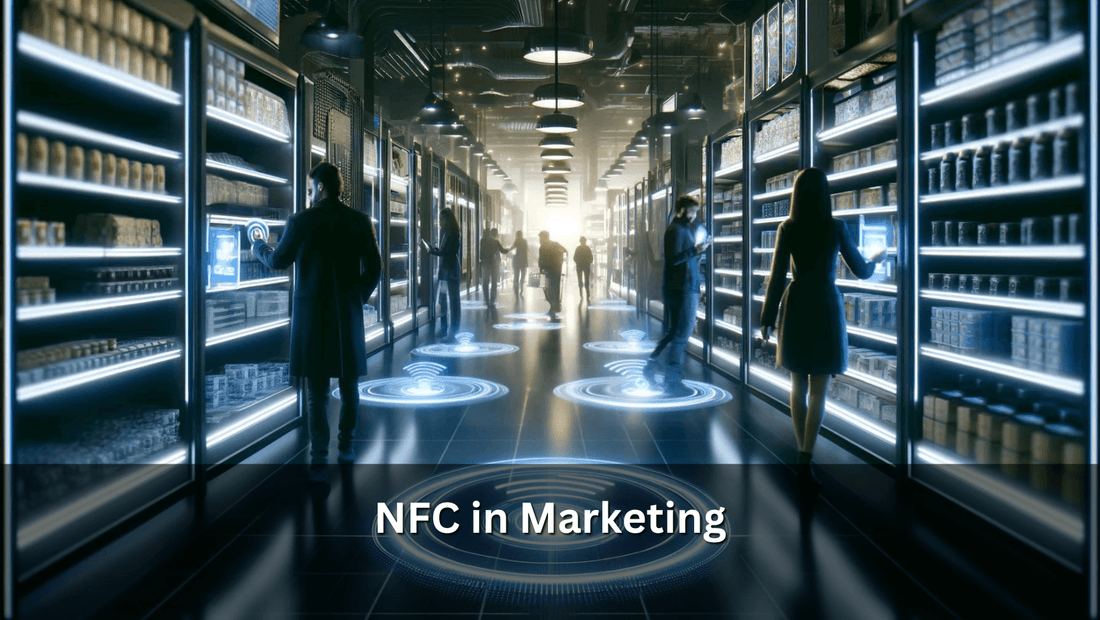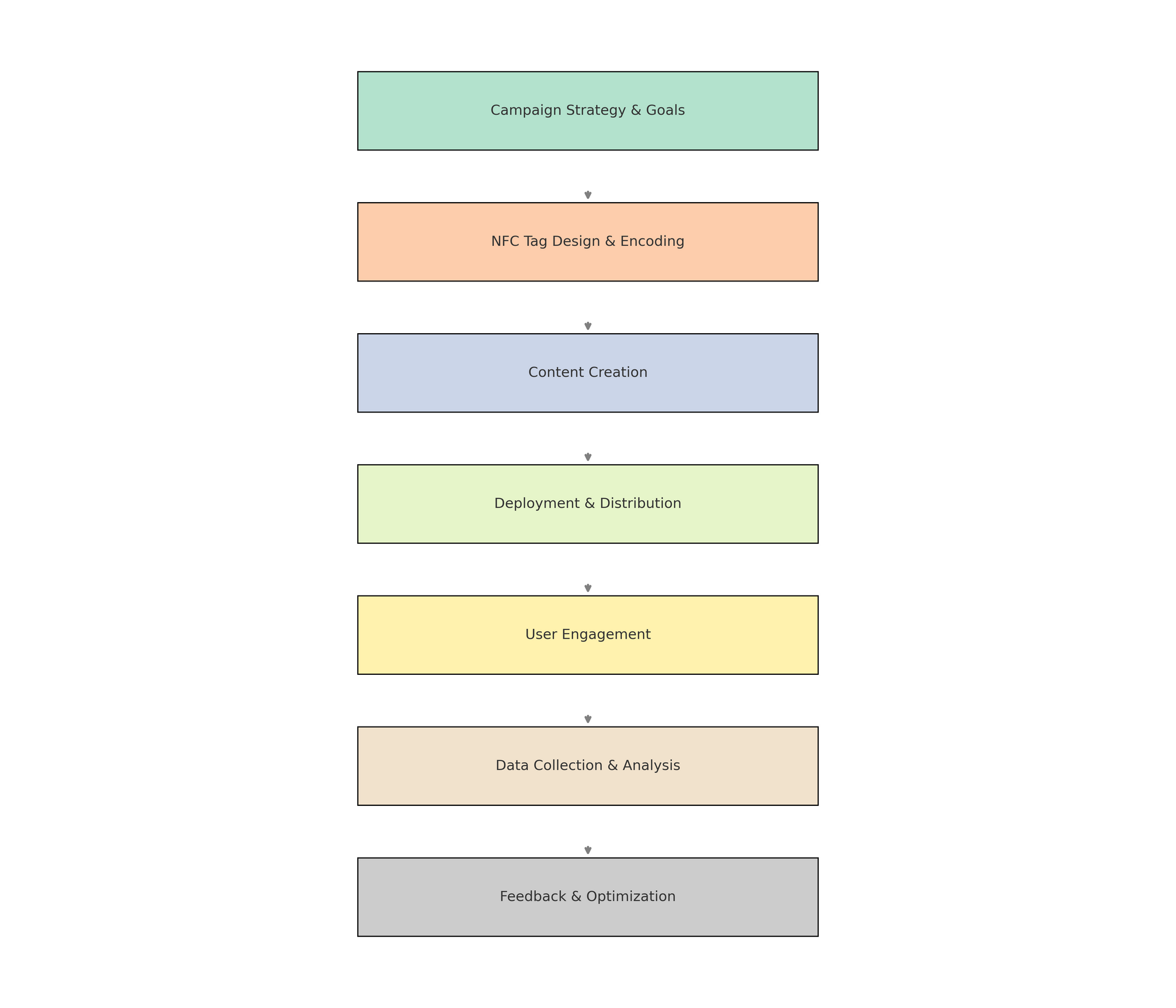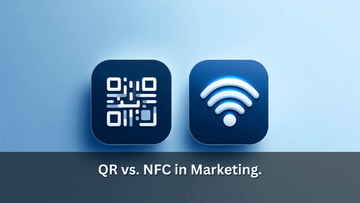NFC in Marketing

Contents
- 1- Introduction to NFC Marketing
- 2- Understanding NFC Technology
- 3- Benefits of NFC in Viral Marketing
- 4- Implementing NFC in Marketing Campaigns
- 5- Creating Seamless User Experiences with NFC
- 6- Ensuring Security in NFC Marketing
- 7- Successful NFC Marketing Campaigns
- 8- Best Practices for NFC Marketing
- 9- Future Trends and Innovations in NFC Marketing
Introduction to NFC Marketing
NFC (Near Field Communication) technology, a staple for secure transactions and quick data exchanges, has significantly expanded its domain into the realm of marketing. Emerging as a pivotal tool in the digital age, NFC enables brands to engage with consumers in a manner that's both innovative and interactive. This technology's journey from a simple tool for contactless payments to a powerhouse in creating immersive marketing experiences exemplifies its growing importance. By allowing a simple tap from a smartphone to trigger a variety of actions — from opening web pages to downloading coupons and even virtual try-ons — NFC marketing offers a seamless bridge between physical and digital worlds. Its ability to deliver personalized content instantly elevates user engagement, making marketing campaigns not only more effective but also memorable. As we delve deeper into the age of connectivity, the role of NFC in marketing continues to evolve, opening new avenues for creating user-centric advertising strategies that resonate well with the tech-savvy consumers of today.
Understanding NFC Technology
Near Field Communication (NFC) is a wireless technology pivotal for close-range data exchange, often between an NFC-enabled device and a tag. It operates on 13.56 MHz and communicates within approximately 4 cm, a design choice prioritizing secure transactions. NFC's roots are in RFID technology, yet it stands apart by supporting two-way communication, fostering interactive information exchange.
Essential elements of NFC are the initiator and the target; the former creates a radio field to activate the latter, allowing data transfer without a target power source. This aspect is crucial for crafting affordable, passive NFC tags for diverse uses such as in marketing materials.
NFC's operational modes—reader/writer, peer-to-peer, and card emulation—extend its utility across sectors, from payments to ticketing and beyond, signaling a broad scope for digital connectivity.
Recent surges in NFC adoption showcase its expanding role in modern technology (NFC Forum).
Benefits of NFC in Viral Marketing
NFC technology offers unparalleled benefits in crafting viral marketing campaigns that stand out for their immediacy, engagement, and personalization. One of NFC's core advantages is its ability to instantaneously connect consumers with a brand's digital content. By simply tapping their NFC-enabled smartphone to an NFC tag, users can instantly access websites, videos, discount coupons, and more, eliminating barriers to engagement and facilitating immediate interaction.
This immediacy is paired with an impressive level of engagement. NFC marketing creates an interactive experience that captivates consumers, transforming passive observers into active participants. For example, an NFC-enabled poster for a movie could give passersby access to the trailer, a behind-the-scenes look, or exclusive interviews with the cast, thereby deepening the consumer's connection with the content.
Moreover, NFC allows for highly personalized marketing experiences. Data gathered during interactions can be used to tailor future content to match the user's preferences and behavior, significantly increasing the relevancy of marketing messages. This personalization not only enhances the user experience but also increases the likelihood of content being shared, amplifying the campaign's reach and impact.
In essence, NFC's blend of immediacy, engagement, and personalization makes it a powerful tool in the arsenal of viral marketing, enabling campaigns that are more dynamic, memorable, and shareable.
Implementing NFC in Marketing Campaigns
Implementing NFC in marketing campaigns can significantly enhance consumer engagement and offer a seamless bridge between physical and digital interactions. Here's a concise step-by-step guide to effectively integrating NFC into your marketing strategies:
-
Objective Definition: Clearly define what you aim to achieve with NFC—whether it's increasing website traffic, enhancing customer engagement, or promoting a new product. Your objective will guide the campaign's structure.
-
Target Audience Identification: Understand who your target audience is and tailor your NFC campaign to match their preferences and behaviors.
-
NFC Tag Placement: Decide on the physical placement of NFC tags. Tags can be embedded in posters, product packaging, or even in-store displays, depending on the campaign goals.
-
Content Creation: Develop engaging and relevant content that will be accessed through the NFC tag. This could range from exclusive offers and multimedia content to interactive experiences.
-
Technology Integration: Partner with an NFC technology provider to program the NFC tags with your content. Ensure the content is easily accessible and provides a seamless user experience.
-
Testing and Deployment: Before full-scale deployment, test the NFC components to ensure they work as intended across different devices and environments.
-
Monitoring and Analysis: Once deployed, monitor the campaign's performance through analytics to understand engagement levels and user interactions. Use these insights to refine and improve future NFC marketing efforts.
By following these steps and considering practical aspects such as tag placement and content relevance, marketers can effectively leverage NFC to create immersive and interactive campaigns.

Creating Seamless User Experiences with NFC
Ensuring Security in NFC Marketing
In the realm of NFC marketing, ensuring the security of user data is paramount. NFC's short-range communication inherently provides a layer of security, as it requires physical proximity to initiate interaction. However, to further safeguard data, marketers can implement several strategies. Encryption is crucial; encrypting the data exchanged between the NFC tag and the device prevents unauthorized access and ensures that even if data is intercepted, it remains unreadable. Additionally, using dynamic URLs or tokens that change with each interaction can prevent cloning or replay attacks, where an attacker mimics a previously successful transmission. Regular updates and security patches for the NFC tags and related software also help in protecting against evolving threats. By prioritizing these security measures, marketers can build trust with consumers, ensuring that the innovative experiences offered by NFC marketing are not only engaging but also secure.
Successful NFC Marketing Campaigns
One of the most illustrious examples of successful NFC marketing campaigns comes from Pepsi. In an effort to enhance customer engagement, Pepsi distributed thousands of NFC-enabled vending machines that allowed customers to connect and interact with the brand in unique ways. By simply tapping their NFC-enabled smartphones against the vending machine, customers could access exclusive music content, download Pepsi-themed mobile games, and even participate in contests to win prizes. This innovative approach not only improved the vending machine experience but also significantly increased customer interaction with the brand outside traditional advertising channels.
Another notable campaign was conducted by Adidas with their NFC-enabled shoes. By embedding NFC tags in the sneakers, Adidas provided customers with the ability to access exclusive content, including training tips, interactive experiences, and brand storytelling, directly through their footwear. This campaign not only fostered a deeper connection between the brand and its customers but also set a new standard for product interaction, demonstrating the vast potential of NFC in transforming everyday objects into gateways for engagement and storytelling. These campaigns exemplify how NFC can be leveraged to create immersive, interactive marketing experiences that drive engagement, enhance brand loyalty, and ultimately boost sales.
Case Study: adidas
Adidas set a benchmark in NFC marketing with their "Hype Key" campaign. To generate buzz around the opening of a new Originals store in Vancouver, Adidas created a contest leveraging NFC technology. Teased via Twitter, the first 150 consumers to reach a secret location were given NFC-enabled "Hype Key Cards." These cards were then used in-store on opening day to reveal if the holder had won a pair of limited edition shoes. This campaign not only spurred immediate retail traffic but also secured a staggering 76% opt-in rate for the brand's newsletter. A prime example of integrating NFC with social engagement strategies, Adidas's campaign showcased the potent blend of exclusivity and technology-driven excitement.
For a detailed exploration, visit the case study here: Wily's case study on Adidas and NFC (Wily Global Insight).
Best Practices for NFC Marketing
For an effective NFC marketing campaign, it's essential to follow best practices such as ensuring clear calls-to-action, simplifying user journeys, prioritizing content quality, and maintaining security to build trust. Regular updates and a focus on user-centric approaches are vital for meaningful engagement. For more detailed strategies and innovative approaches to NFC marketing and advertising, enhancing promotional efforts, and creating interactive consumer experiences, refer to the comprehensive guide available at ENC Store's blog on NFC Marketing and Advertising. This resource can offer deeper insights and additional best practices.









